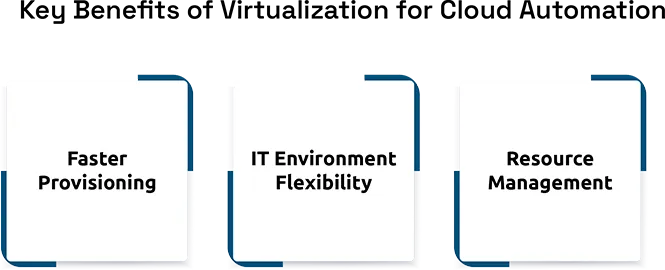Controlling present-day data centers requires several resources and efforts to make them operational. The studies show that more than 80% of IT executives admit to having challenges with regard to resource utilization and management in cloud solutions. Virtualization and automation come into the picture at this stage.
On a basic level, therefore, virtualization refers to the process through which servers, networks, or storage devices are duplicated in a virtual environment. Data center automation can therefore be described as the use of technology in performing functions in the data center based on certain triggers without necessarily requiring human intervention. Computer services can be accessed through the web, and this involves using computing resources from a provider through the internet, also known as cloud computing. Altogether, these three attributes enhance the speed and cost-effectiveness of managing large volumes of data centers.
Here the writer aims to perform research on how virtualization aids in the automation of cloud data centers. After reading through this book, you will know what virtualization entails, why it is crucial, and get insights on how to apply it.

Virtualization: The Foundation of Cloud-Based Data Center Automation
In other words, Virtualization, also referred to as Virtual Computing, is the replication of an item, including a server, terminal, storage unit, or even a network, in a virtual format over the internet. It is now possible to perform different types of tasks in virtual machines (VMs) and require fewer physical hardware in fewer quantities. These help in aspects such as being compact, economical on power, and, more so, cheap.
Indeed, flexibility is possible through virtualization since it is possible to engineer your infrastructure to move up or down. Your business does not need to wait for installations in computer hardware. As for the virtual resources, it is more or less possible to simply add or delete them right in the course of the process of work. This enables automation of solutions in cloud environments to be most effective.
Also, the application of virtualization has the advantage of flexibility and agility when it comes to data centers. It enables IT professionals to assess the impact of new applications or configurations on the environment through a replication of the regular system without necessarily exposing it to risks. Such an approach minimizes risk and equals time between screening and production, as pointed out in the case of sandboxing above.
Why Virtualization Is Vital for Data Center Automation in the Cloud
In implementing cloud data centers, by using virtualization, the available resources can be used in the best way possible. For instance, it is very possible to host many virtual machines on one physical server, fully utilizing the server. Fewer servers are required, and this brings in savings and ease of operation.
Virtual resources are also very malleable in terms of location and duplication. This helps in disaster recovery. Virtual machines have the ability to reboot on another server in case of the occurrence of an odd circumstance. This is something that the automation tools are capable of doing on their own without the need to involve a human being.
Also, virtualization is “high availability and business continuity ready.” Live migration is one of the critical success factors when it comes to virtual machines, where the entire machine, including other related entities, may be moved from one host to the other in the least possible time and with least or even no interruption to ensure that there’s continuity of essential applications to the users. Such a level of availability is needed to keep the services up and running, and it is critical for SLAs, which are highly valuable when it comes to clouds.
Key Benefits of Virtualization for Cloud Automation
Virtualization supports faster provisioning. There is usually a very low development time since new applications and services can be launched in a matter of minutes. Automation tools can build new virtual machines on instantiation on the basis of your settings. This in one way reduces time and enhances speed.
The last advantage is that it enhances the handling of resources needed for any project. Virtual computers may be switched on or off whenever required. This means that the need for virtual machines is not as fixed as that of physical computers. There are automated systems that can track workloads and then distribute them across the different servers where the work is supposed to be done in an efficient manner, or else to avoid the filling of a particular server to its full capacity limit.
Third, virtualization benefits deployment, testing, and development of IT environments. It can be used to create many temporary VMs in a short amount of time to apply changes to new applications or new updates of existing ones without affecting the rest of the structure. This has the advantage of increasing productivity and enhancing the likelihood of success because the environment provided is flexible and can mimic real-life situations, and if something goes wrong, which is likely to happen when trying out new ideas and techniques, they can undo the alterations. This, therefore, results in effective and efficient carrying out of DevOps with the help of automation.

Technologies That Support Virtualized Automation in the Cloud
A hypervisor is the master of the VMs — It is termed as a Virtual machine manager or virtualization layer. There are two categories, namely: Type 1, the greatest functionality is provided directly at the hardware level, and the second Type uses a host OS to operate. Several hypervisors in the world are widely used, and some of them are listed below: KVM, Hyper-V, and VMware ESXi. These are key to automation.
Virtual environment automation is made possible by Cloud Management Platforms (CMPs). They relate to other forms of automation tools such as Ansible, Chef, or Terraform. They are script-based tools that help in deploying virtual machines, updating the systems, and even in a system backup.
Simple Strategies to Get Started with Cloud Automation Using Virtualization
First of all, there are certain tasks that may be repetitive or take considerable time to complete. These might be backups, software upgrades, or escalation of the resources used in an organization. Then, these can be automated through the use of virtualization tools and cloud platforms.
Being an important component of business solutions, cloud services and virtualization tools must be selected depending on the user’s needs. If you are already employing AWS, Azure, or Google Cloud, look for built-in automation tools inside all three platforms. Another aspect is to use such Infrastructure-as-Code (IaC) tools as Terraform for management of virtual machines and networks.








